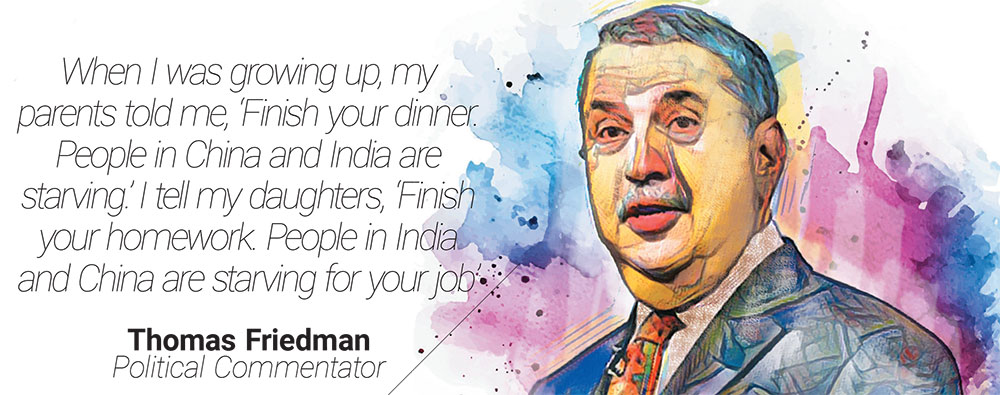Delivering his “Tryst with Destiny” speech at the hour of India’s independence in 1947, Jawaharlal Nehru felt relieved that India’s “period of misfortune” had ended. Believing that India was ready to “discover herself again”, Nehru dreamt of the future bringing “freedom and opportunity to common man, to the peasants and workers of India; to fight and end poverty and ignorance and disease; to build up a prosperous, democratic and progressive nation”.
Visioning another tryst with India’s destiny, on India’s 75th independence anniversary, Prime Minister Narendra Modi called for making India a “developed nation” by 2047, though he did not spell out what signifies a “developed nation”.
Today, India, with a $3 trillion gross domestic product (GDP), is the fifth largest economy in the world. But, with a per capita income, which measures economic poverty/prosperity of people, of about $2,000, India languishes close to the 120th spot in the world.
Global GDP is about $90 trillion. Global average per capita GDP exceeds $10,000. The US, Japan and Germany—three of the four countries ahead of India in terms of GDP—clock an average per capita income exceeding $50,000. China, the other country ahead of us, averages $12,000 in per capita. India’s per capita GDP is way behind the four countries ahead of us in GDP and is not even 20% of the global average. India will certainly overtake Germany and Japan in the next few years to become the nation with the 3rd largest GDP in the world when its per capita income will still be below $3,000.
India started out in 1947 as one of the least developed countries, according to the UN system of development classification. With 80% of its people extremely poor, India got categorised as a low income country (LIC) in the World Bank’s classification of countries based on per capita income. It took India more than 50 years to move out of the class of LICs.
To adopt a path to redeem the pledge of becoming a developed nation by 2047, we need to first define our benchmark of a developed nation, as there is no globally accepted definition of a developed country.
Breaking into the club of high income countries (HICs) can be one such good indicator. The current World Bank threshold for an HIC is the per capita income in excess of $13,000. China is on the verge of getting into the HIC club after it clocked over 8% growth in the GDP for 40 years to attain this milestone, especially when its population growth rate was constantly declining. To put it in context, the $13,000 per capita income is about six times India’s current per capita income.
Attaining this target at the 2022 dollar value by 2047 looks improbable. With India’s population expected to stabilise at around 155 crore to 160 crore by 2050, an average per capita income of $9,000 to $10,000 in the 2022 dollar vlaue—which will mean a GDP of about $15 trillion—will be an ambitious and decent goal to make India a developed nation.
Dreaming, pledging and speaking about making India a developed nation is, however, the easier thing to do. Defining and determining goals and the path are way more challenging.
Getting there will be the most demanding task. Development, growth, raising per capita income and containing income and wealth inequalities are all about adopting right policies and marshalling human resources better for seizing the future drivers of growth.
Indians are poor because 50% of workers are trapped in low-income agriculture jobs. Our opiatic policy cocktail of minimum support prices and all-pervasive input subsidies (fertiliser, power, loans, seeds, etc.) with low wage employment under MGNREGA and survival transfers under the PM Kisan scheme) keep 20 crore farmers and landless workers below poverty line. To liberate them for better lives, the yoke of innumerable controls, restrictions and constraints would need to be cast away on leasing of lands, contract farming, conversion of land for non-agricultural use and marketing freedom for their produce. These teeming millions will need to be retrained and reskilled to ensure that not more than 10% of India’s workers produce 10% of $15 trillion GDP in agriculture in 2047.

Industrialisation has created most of global value, income and wealth in the last 200 years, making industrialised countries the developed countries of the 20th century. Industrialising India has also been the government priority since independence. However, wrong policy choices of too much reliance on the public sector, caging private enterprise in licence-permit-quota raj and ill-designed land, labour, credit and taxation policies made India miss the industrialisation bus.
Manufacturing remained stalled around 15% of the GDP. The current policy frameworks of Make in India, phased-in manufacturing, production-linked incentive scheme, high tariff protection, etc. will not make much difference either, in the absence of real technological innovation and competitiveness. Let the government walk the talk on privatisation by selling off public sector enterprises, including banks, lock, stock and barrel, and completely free up and expose the private sector to global competition and eliminate cross-subsidisation in power, land, loans and others disfavouring industry to make Indian industry globally competitive.
India’s real big opportunity lies in services, vastly aided by the digitalisation revolution. India’s current services exports, supplemented by remittances, which are nothing but surrogate services exports, ratchets up to 75% of merchandise exports. Indians have proved their value all over the world in delivering quality medical, education, financial, digital and legal services. India needs to be bold to seize this once-in-an-epoch opportunity. For this, we must open up all these services to foreign investment. Let the world bring foreign direct investment to set up best educational, financial, digital, health and legal firms in India. Indians will be predominantly employed in these businesses. They will get the best global education to get employment all over the world. If we can generate 75% of the GDP in 2047 from the services, Indians will be a lot more prosperous.
Digital economy is the future economy. Of the four key parts of the digital economy—chips, code, networks and services—we are good at only services. Almost 100% of the chips we use are imported. Our data localisation and other policies thwart building of national and global scale digital networks and businesses, including social media—the future of communication and entertainment. Data is the heart, soul and raw material for products and services. If we adopt open and progressive data and ecommerce policies, we can become a leader in digital economy.
We must also focus on securing a better quality of life by making fast energy transition without worrying about climate equity. Today, rampant pollution of air, water and land makes the quality of our lives poor. Pollution control should become the most important public policy objective. If we are able to build a productive, sustainable and profitable environmental and circular economy by shifting to wind, solar and other non-fossil fuels to generate the power to run our homes, businesses and machines, we can truly usher in a healthier and developed India by 2047.
If we are able to make this ambitious policy pivot, India’s prime minister, when addressing the nation on the 100th anniversary of independence, will be able to confidently tell the nation that India has successfully redeemed the pledge made in 1947 and 2022. India, with its wholesome environment, highly digitalised and three-fourth service economy and all its people enjoying healthy, prosperous and happy life, will have arrived and become a developed nation.
Subhash Chandra Garg, Former Union Finance and Economic Affairs Secretary











